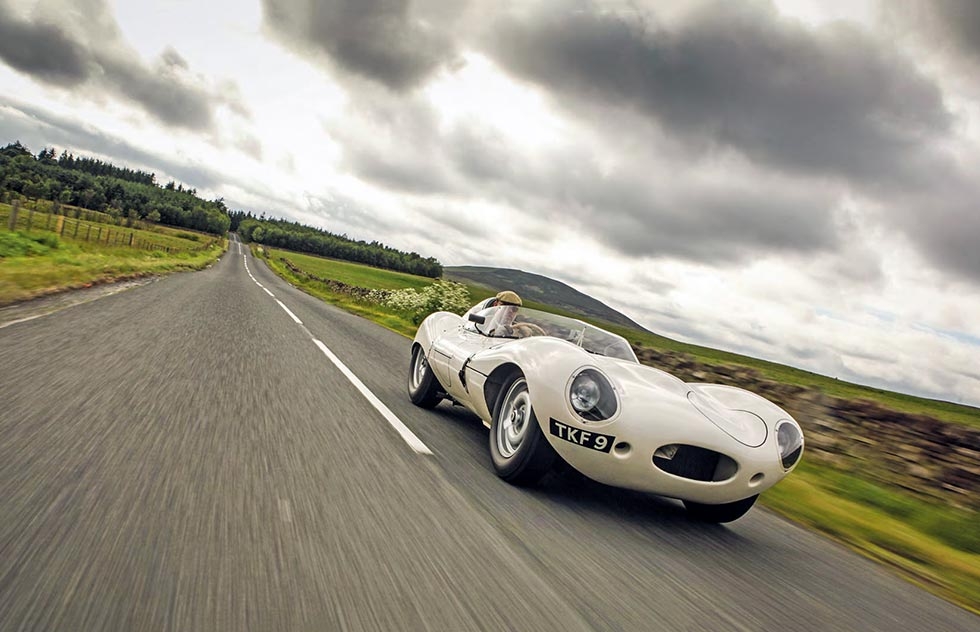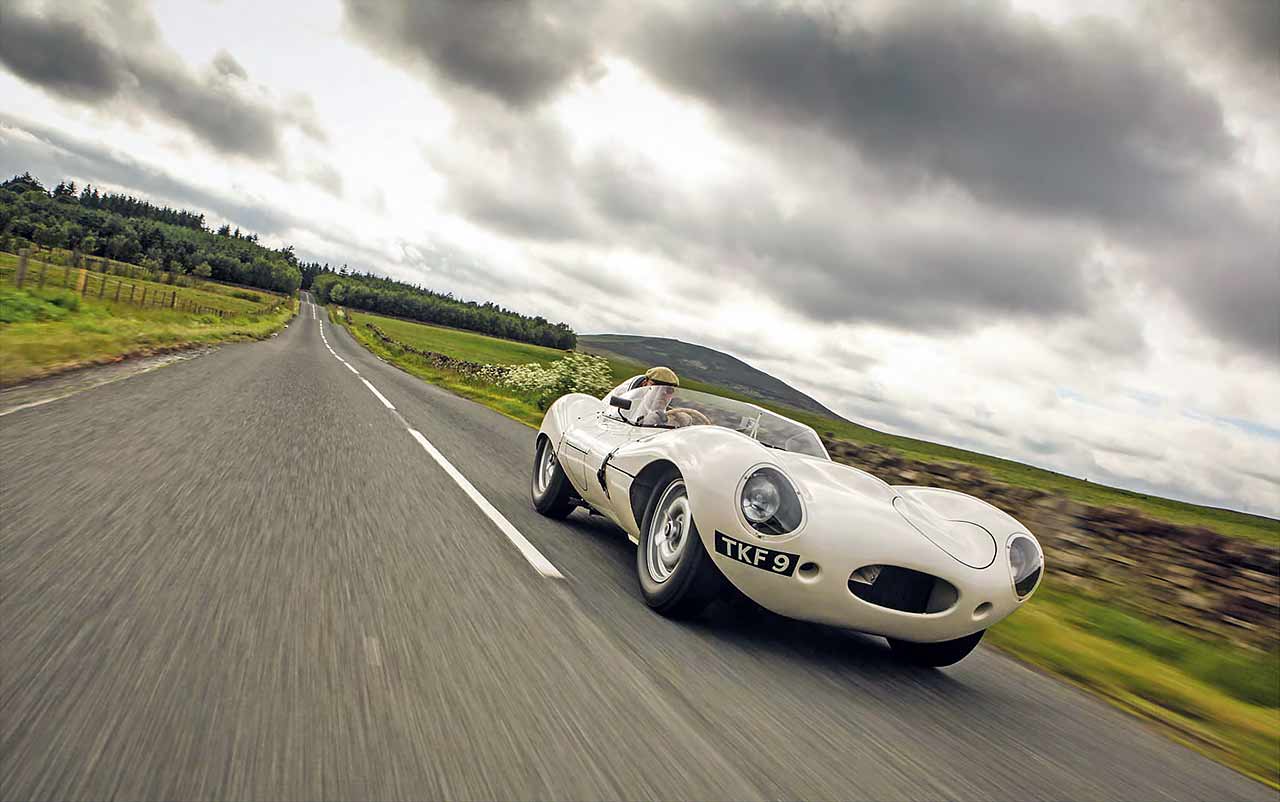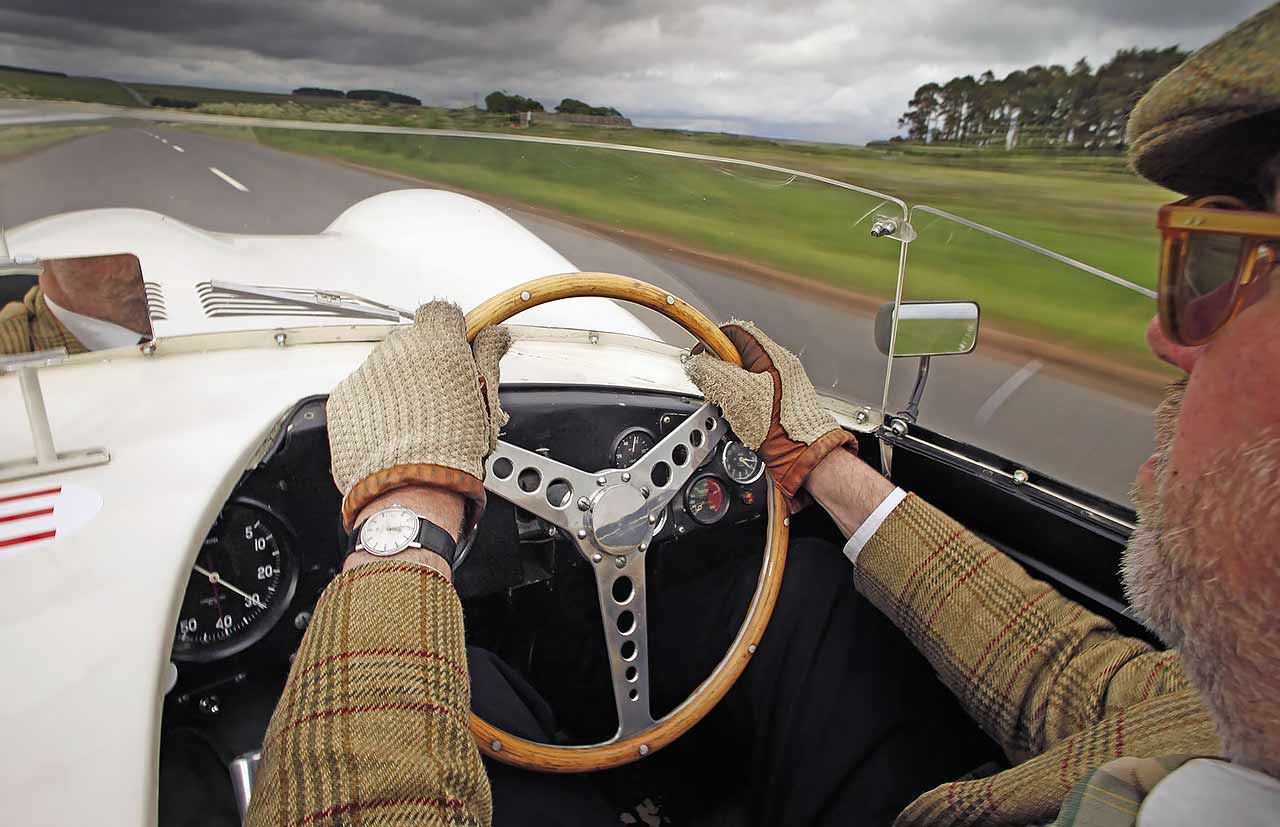
Jaguar D-Type on the road – Scottish pilgrimage in Kim Clark’s racer – plus meeting the legend’s mentor. Raiding the Borders in Clark’s D-type. This Jaguar set a young Berwickshire farmer on the path to motor-sport glory. Julian Balme enjoys the drive of a lifetime as he follows in his hero’s wheeltracks. Photography Tony Baker.
Jim Clark’s D-type On the road in Scotland, plus meeting Jimmy’s mentor Ian Scott Watson / Jaguar odyssey We take Jim Clark’s old D-type back to the roads where he honed his skills
Only twice did I actually see him race and, to be honest, I just have recollections of the second time – the 1965 British Grand Prix at Silverstone. Having conceded the first couple of corners to Ritchie Ginther, he led more or less from flag to flag in the Coventry Climax-powered Lotus 33, possibly the prettiest of his ‘cigartubed’ single-seaters. Yet strangely it wasn’t the combination of car and driver that burnt their way in to my memory banks. In those days, rather than checking that he had the correct watch and sponsor’s hat on before being rushed off to a media scrum, the winner had his car placed on a low trailer and – along with mechanics, team principals and friends – was hauled around the Northamptonshire circuit behind a tractor to receive the applause of the crowd.

As they passed our vantage point at Abbey Curve, my father lifted me above the single scaffolding pole that acted as crowd restraint so that I could get a good view of my schoolboy hero. In his late 20s, he had film-star looks below his head of raven-black hair, a modest and shy personality and more ability behind the wheel than anyone of his generation. He could even wear unflattering farmer’s knitwear and still look cool. He was, of course, Jim Clark.
Clark was no stranger to a tractor, or a beige crew-neck sweater. His family was immersed in farming and naturally, being the lone son (he had four older sisters), he was expected to carry on the tradition. Jim was born in Kilmany near Dundee, but the Clarks moved south to Berwickshire in 1942 when he was just six-years old. His father, James Snr, had bought a large farm called Edington Mains just outside the village of Chirnside, which, apart from a year spent in Paris as a tax exile, would remain Jim’s home and bedrock for the rest of his life. This area, north of the Tweed, was considered to contain the most prized agricultural land in Scotland. It also possessed some magnificent driving roads and more than its fair share of motor-sport enthusiasts.
One such was Chirnside’s main Ford dealer, Jock McBain. It was at McBain’s garage that Clark would drop in to pick up tractor parts as well as chat about local rallies, racing and the proprietor’s ramshackle team of 500cc racers, Border Reivers. In contrast to Edinburgh’s slickly run, Le Mans-winning Ecurie Ecosse, McBain’s small band had a romantic rather than businesslike approach to its racing; though the team would sharpen its practice following the involvement of Ian Scott Watson, a local architect and Clark’s patron. Although a keen driver himself, Scott Watson recognised how talented the young farmer was and soon started to forgo his own drives in favour of Clark.

For 1958, and fuelled by the star within their midst, the equipe’s ambition took a giant leap when McBain saw an advert in Autosport for a three-year-old Jaguar D-type. The very same white D-type, in fact, in which we meet Ian Scott Watson outside the Jim Clark Room in Duns. “It’s a lot nicer now than it was back then,” he says. “Henry Taylor had raced it in 1957 and crashed it at Silverstone, so the panel fit was never that good. The driver’s door always looked as though it was half-open.”
Thanks to the generosity of the car’s current owner, I am in the middle of making my own pilgrimage. Armed with what has to be Jaguar’s ultimate racing thoroughbred, I am visiting the roads and places where my hero had honed his skills in the late ’50s – and from the very same seat in which his career would truly start. Until the arrival of TKF9, Clark hadn’t raced anything capable of topping the ton, but with the Jaguar he was suddenly embracing speeds of 170mph. At his maiden race with it – at Full Sutton in North Yorkshire – he would become the first person to lap a UK circuit at more than 100mph in a sports car. It almost goes without saying that he took the win.
In early April, when the meeting was held, there was still snow on the ground in the Borders, so the D-type was loaded onto one of Clark’s farm lorries. Convoying with Scott Watson in his Porsche 356, the truck barely made it to Berwick before they discovered that the stop taps on the cooling system had been left open and the fresh antifreeze had simply passed through and onto the hay below. Being the early hours, there was nothing for it but to unload the Jaguar and drive it the rest of the way.
“It was very dark and the headlights were hopeless,” remembers Scott Watson, “but that didn’t seem to hold Jimup. He was worried about the plugs fouling so every so often he would give it a blast. We’d get to 100mph and he’d still be accelerating down the A1.”
By all accounts the howling din from the open pipes as he sped through Newcastle city centre in the dead of night was something to behold. The car isn’t much quieter today but, true to its manufacturer’s intentions, it is still tractable on the public road. Given that it won its most recent race at Brands Hatch just three weeks ago, I am concerned that it might be an animal but, as preparation specialist and historic racer Gary Pearson rightly says: “It’s a pussycat.”
I don’t possess the most svelte of physiques and, as we fire up the straight-six for the first time, a wave of panic sets in – what if I don’t fit? Getting in requires stepping over the tall sills, through the open door before standing on the seat squab and then lowering your body until you’re cocooned by the full-width ’screen.
Once ensconced, the notion of staying in such a welcoming cockpit, even for 24 hours, doesn’t seem in the least bit daunting and, apart from the throttle pedal being fractionally closer to the transmission tunnel than desired, everything fits like a glove. Over to the left of the dashboard is the round Bakelite starter button that instantly brings the race-spec engine to life.
Clark was always aware of the car’s power, even apprehensive on occasion. The first test with the Jaguar at Charterhall – his local track – unsettled him, particularly the long start-finish straight where, in his second race, the brakes locked and pitched him into a spin. Any fears he had about being out of his depth with the D-type weren’t dispelled by his first race abroad at Spa Francorchamps. The events there on 18 May 1958 would cement his hatred of the place, despite it being a circuit on which he would score a number of successes in the future.
He’d never encountered such opposition, the grid featuring the American pair of Carroll Shelby and Masten Gregory, plus Paul Frère, Olivier Gendebien, Ivor Bueb, Jack Fairman and, most significantly, Scott Watson’s old schoolmate Archie Scott Brown. Greeted by typical Ardennes showers, Clark was nervous before the start but drove with great maturity, keeping well within his limits.
He was lapped by the Lister-mounted Ecosse pair of Gregory and Scott Brown at such a rate that it shook him almost as much as the D-type, the bow wave blowing him and the car across the track. Another brief, isolated shower would catch out Scott Brown and the resulting crash led to his death. “Jim came across the scene not long after it had happened,” remembers Scott Watson. “He was very distressed and that’s why he hated the place ever after.”
If Clark thought the Jaguar too fast for him, Lord knows what mere mortals like myself are supposed to think but, having stalled it twice, I reckon I have the measure of the clutch – the only marginally fierce thing about this historic racer. With such a narrow gate, shifts are direct but require quite a bit of effort, the firm gearlever being canted forward in such a way that second looks and feels like a conventional first.
Out on the Border roads the pace of the D-type belies its age, and the spaceship performance – especially compared with Clark’s TR3 or Scott Watson’s DKW– is echoed by its styling. It looks 20 years younger than its predecessor, the C-type, rather than only two – particularly in works guise, with its fin stretching out behind the headrest. If Dan Dare had been a racer he would have driven a Jaguar D-type.
The Dunlop alloy wheels alone illustrate just what a futuristic machine it was. When Ferrari was still using wires, this meticulously engineered thoroughbred was constructed with materials and design techniques more common in the aircraft rather than automotive industry. No matter how successful the C-type had been in long-distance sports-car racing, it was the D that really embodied the best of British. Blasting along the likes of the arrow-straight B6456, a dry-stone-wall-flanked version of the Mulsanne, it is easy to recognise the Le Mans pedigree and, with so little traffic, only bravery limits the car’s terminal velocity. The rasp of the Jaguar’s side-exit exhaust bouncing off the masonry is intoxicating.
On Dunlop ‘L’ race crossplies, however, wandering onto the white lines in the centre of the road quickly recalibrates the senses, the resulting shimmy worrying the driver almost as much as the nearby flocks of sheep.
Everything else about the Jaguar’s componentry lives up to its intended job. The brakes are remarkable, possessing a reassuringly firm pedal even from cold and, despite the terrible lock, the steering is perfectly weighted. The only thing I have in common with its former driver is the desire to stay with in my capabilities, so exploring the car’s handling parameters – particularly on the public highway – seems inappropriate. There is enough to suggest that the D-type might be tail-happy and, given how staggeringly quick a machine it is, it’s no wonder that the future World Champion was respectful of the car.
Considering that the Jaguar is a front-runner in today’s historic racing, it’s incredible to think that I have completed 70-odd trouble-free miles around the roads surrounding Chirnside, Charterhall and Duns. Even driving down the latter’s high street, being pointed at by school children, the temperatures remain static and its behaviour impeccable. The ride is stiff but, even after driving on single-track moorland roads, I emerge from the cockpit unshaken. Heavy rain showers try to unsettle me yet, despite the exposed cockpit, the car keeps me dry; though once I finally stop alongside the clock dedicated to Clark in Chirnside, I get so soaked that a couple comes out of the pub bearing gifts of bar towels.
In 20 outings with the Jaguar during 1958, Clark finished all of them and won 12. His final meeting in it was at Charterhall, where he scored three victories. But it was his final race there on 28 September that convinced him to pursue, much against his parents’ wishes, a career in motor sport. David Murray had entered Ron Flockhart and Innes Ireland in Ecurie Ecosse D-type and Tojeiro Jaguar respectively. Both were shod with the latest R5 Dunlops whereas Clark was still using the outdated R3s. Despite this, he drove the Reivers D-type to the threshold of his and the car’s ability – probably for the first time – managing to stay with the far superior blue machines from Merchiston Mews in both the sports car and Formule Libre encounters.
In the second race, Ireland spun, leaving Jimmy to finish second, just behind experienced Grand Prix racer Flockhart. As Clark later wrote in his autobiography: ‘These two races gave me a great deal of confidence, for I realised that I could at least race with people of that stature, driving the D-type on its limit and still keep up.’
This second-hand Jaguar would determine the destiny of the Berwickshire farmer. For me, apart from it being a huge privilege, I was reminded of just what a joy driving a fast car on deserted roads can be and how, before 1968 had concluded, I’d lost both my heroes from that day at Silverstone – my father and Jim Clark.
Thanks to Gary Pearson and ‘Pops’ at Pearsons Engineering, James Haithwaite
This Pure Driving Experience was brought to you in association with Dunlop. Tell us your own driving adventures and win prizes at www. classicandsportscar.com/forum
A varied history
Chassis number XKD 517 was built in 1955 and first sold via Henlys to Gilbert Tyrer, a Liverpool garage owner and racer of a well-known BMW 328. Registered TKF 9, it had passed to the Murkett Brothers – Huntingdon Jaguar dealers – within a year. They engaged the services of Grand Prix driver Henry Taylor. He competed throughout 1957 in the repainted D-type, scoring a win at Snetterton and a third at Spa before the car was sold to Jock McBain.
Following Clark’s year with the D-type, Border Reivers sold the 12-time winner to Alan Ensoll, who promptly had it re-configured as an XKSS. Its next owner, Bob Duncan, raced it like that in Northern Ireland before moving it on to Shrewsbury solicitor Bryan Corser in 1964. He restored the D-type back to its proper shape and painted it British Racing Green, maintaining it until 1979 when it was bought by Willie Tuckett and campaigned in historic racing.
Neil Corner acquired the car in the mid-1980s, and it stayed with him for 20 years. The Jaguar finally changed hands in 2006, when the new custodian, Eric Heerema, had it restored, in the process changing it back to white. Heerema sold it on again in 2009 to its current owner.
Tech and photos
TECHNICAL DATA FILE SPECIFICATIONS JAGUARD-TYPE
Sold/no built 1954-’1957/62 (plus 16 Jaguar XKSSs)
Construction magnesium-alloy semi-monocoque, with tubular steel front sub-frame
Engine iron-block, alloy-head, dry-sump, dohc 3442cc ‘six’, with crossflow head, triple twin-choke Weber DC03 carburettors;
Power 250bhp @ 6000rpm / DIN nett
Torque 248lb ft @ 4500rpm / DIN nett
Transmission all-synchromesh four-speed manual, driving rear wheels via LSD
Suspension: front independent, by longitudinal torsion bars, wishbones, a-r bar rear live axle, twin trailing arms, transverse torsion bar; telescopic dampers f/r
Steering rack and pinion
Brakes 12 ½ in (324mm) discs, with gearbox-driven Plessey pump servo
Wheels and tyres alloy 16in centre-lock discs, with 6.50x16in Dunlop Racing crossplies
Length 12ft 10in (3910mm)
Width 5ft 5 ½ in (1660mm)
Height 3ft 8in (1120mm)
Wheelbase 7ft 6 ½ in (2300mm)
Weight 1930lb (875kg)
0-60mph 4.7 secs
Top speed 160mph (depending on axle ratio)
Price new £3633 (’1954 UK)
Now (2018 UK) from £5m
‘THE IDEA OF STAYING IN THIS COCKPIT, EVEN FOR 24 HOURS, IS NOT AT ALL DAUNTING’
‘ON ARROW-STRAIGHT ROADS, IT IS EASY TO RECOGNISE THE CAR’S LE MANS PEDIGREE’
Left: McBain (on left), Clark and Scott Watson with the Reivers D-type. Below right: Scott Watson today; Balme takes a breather in Chirnside. Above: the Charterhall Circuit has now fallen silent, but it was here in 1958 that Clark (bottom) scored perhaps his most significant early success. Below: tackling minor roads on the way to Duns. Clockwise: Balme in full flow on Border roads; Clark’s grave at Chirnside; D-type returns to Edington Mains; steering is nicely weighted; XK powerplant.





